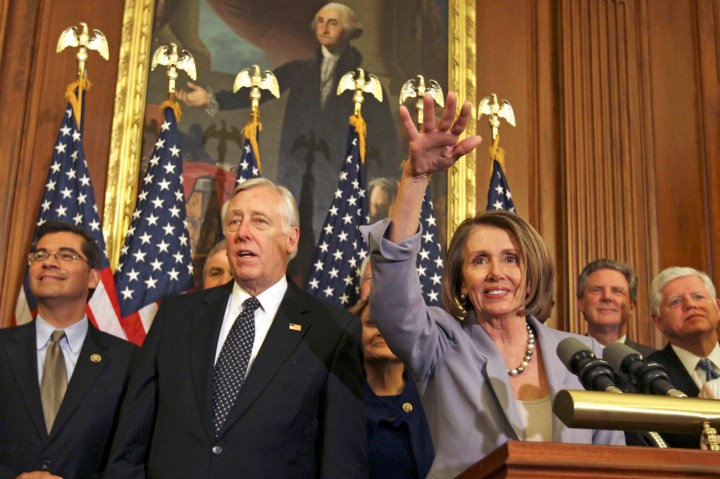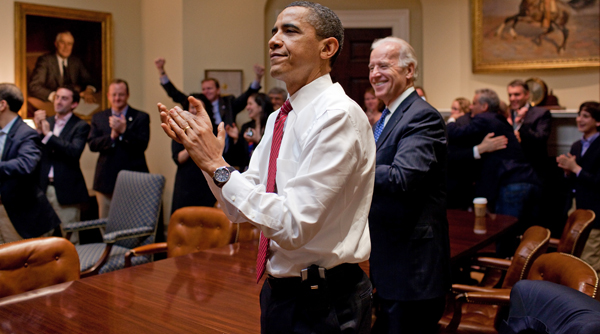Business Maverick, Politics
US Congress hands President Obama historic victory

The Democratic majority in the US Congress passed historic legislation on Sunday night that will provide healthcare insurance benefits to more than 30 million uninsured Americans, simultaneously cracking down on insurance company abuses.
This vote was a crucial milestone in a century-long effort to achieve nearly universal healthcare coverage. Speaking on TV just moments after the vote, President Barack Obama cheered, “This is what change looks like,” echoing his campaign promise of “change you can believe in”. The passage of a healthcare measure that had been declared all but dead for this electoral cycle has now become a crucial part of Obama’s effort to revive his flagging presidency and prove his administration can make the tough scores.
This victory has major ramifications for America’s upcoming November mid-term elections. Democratic candidates for Congress in traditionally Republican-leaning districts will be special targets for the Republicans, if they voted for the bill. However, Democrats will now be able to reply that the healthcare reform measure is a clear demonstration that a determined Democratic president and congressional majority can decisively break deadlocks in Washington.

Photo: President Barack Obama, Vice President Joe Biden, and senior staff, react in the Roosevelt Room of the White House, as the House passes the health care reform bill, March 21, 2010. (Official White House Photo by Pete Souza)
On Sunday, the house of representatives, after some final arm-twisting by Obama and speaker Nancy Pelosi, passed by a 219-212 vote the same measure the Senate had previously supported, thereby setting a path around the Republicans’ threat of unlimited debate in the Senate if a joint House-Senate conference measure had to be voted upon all over again. The final tally for Sunday’s vote showed every Republican and 34 dissident Democrats against the bill. Then a second measure, making some small but crucial changes in the bill, passed by a 220-211 vote. That second measure, not the actual substantive bill, now goes to the Senate. There, Democratic leaders say they have the votes to pass it this week.
Under this measure, insurance companies and healthcare providers now face either smaller-than-anticipated payments from Medicare (the government health insurance plan for the elderly) or higher taxes. As a result, in the days leading up to the vote, health insurance providers launched a barrage of well-funded media attacks against the proposed measure. Republicans and other conservative interest groups such as the so-called “tea party” groups charged that the measure means a government take-over of the healthcare industry, it would bankrupt the country and would lead to global warming (ok, ok, they didn’t make that last charge – but probably only because they didn’t think of it at the time).
The deal was finally clinched when Obama and his party’s congressional leaders reached a compromise with a group of Democratic, but anti-abortion congressmen. Obama’s office announced he would issue an executive order pledging no federal funds could be used for elective abortions. With that, Michigan Democratic congressman Bart Stupak and his supporters said they were satisfied – and the deal was done.
Watch: President Obama On the Passage of Health Reform
The non-partisan congressional budget office previously said the new measures would extend coverage to 32 million Americans who now lack it, it will prevent health insurers from denying coverage because of pre-existing medical conditions and, importantly, it will also cut deficits by an estimated $138 billion over a decade, and a whopping $1.2 trillion in the following decade. If fully accomplished, this coverage expansion would reach 95% of eligible individuals (i.e. excluding illegal immigrants) under age 65.
The measure would require most Americans to purchase insurance and much of the actual cost of the measure is a series of subsidies to assist families whose incomes are as high as $88,000 a year, to help pay their health insurance premiums. This helps erase the health coverage gap for working-class families who now struggle to get healthcare coverage. The bill also expands Medicaid, the federal-state healthcare programme aimed at the poor.
To help pay for it all, the plan includes over $400 billion in higher taxes over the next 10 years, with roughly half from a new Medicare payroll tax on individuals who earn more than $200,000 (or $250,000 for couples). In addition, there are cuts of more than $500 billion in planned government payments to hospitals, nursing homes, hospices and other providers that treat Medicare patients. This is aimed at encouraging higher efficiencies of care. There are also cuts in planned subsidies to insurance companies that offer private alternatives to the government Medicare plan.
The second subsidiary measure included another compromise to gain the support of some reluctant left-leaning Democrats – providing funds that would close a gap in Medicare prescription drug coverage for the next 10 years, including rebates for the elderly to help them cope with growing drug costs. The pharmaceutical industry, unlike the insurance companies, had earlier come on board in support of the healthcare reform package and had paid for television ads to support it. In an effort to pick up yet more Democratic support, the second measure made major changes in the government’s student loan programme, reorientating the loan funds from being disbursed through banks to providing the loans directly from government to students.
While the president and vice president watched the voting on TV, protesters outside the Capitol building called out “Just vote no” in a futile attempt to stop the inevitable. Republican congressman John Boehner, the minority leader, commented, “We have failed to listen to America,” and promised to use this loss to energise their fight into the mid-term elections to wrest control of Congress from the Democrats. Many Republicans also promise, should they win in November, to reverse the reform.
This sets up the mid-term election as referendum on the president’s plans and, now, on his accomplishments as well. And if you thought the healthcare reform disagreement was nasty, just wait. Seven months from now, it will be looked upon as a quaint memory.
By J Brooks Spector
For more, read the AP, the New York Times, Time and the Washington Post here and here.
Watch: GOP Senator Tom Coburn from Oklahoma warns seniors their lives will be shorter
Watch: The right-wing’s High Priestess, and GOP congresswoman from Minnesota, Michelle Bachman, in full fantasy swing. Well-worth watching.
Main photo: House Democratic leaders celebrate healthcare bill passage after vote on Capitol Hill in Washington, March 22, 2010. From L-R are: Democratic Caucus Vice Chair Xavier Becerra, House Majority Leader Steny Hoyer, Speaker of the House Nancy Pelosi, unidentified, and Caucus Chair John Larson. REUTERS/Larry Downing




















 Become an Insider
Become an Insider